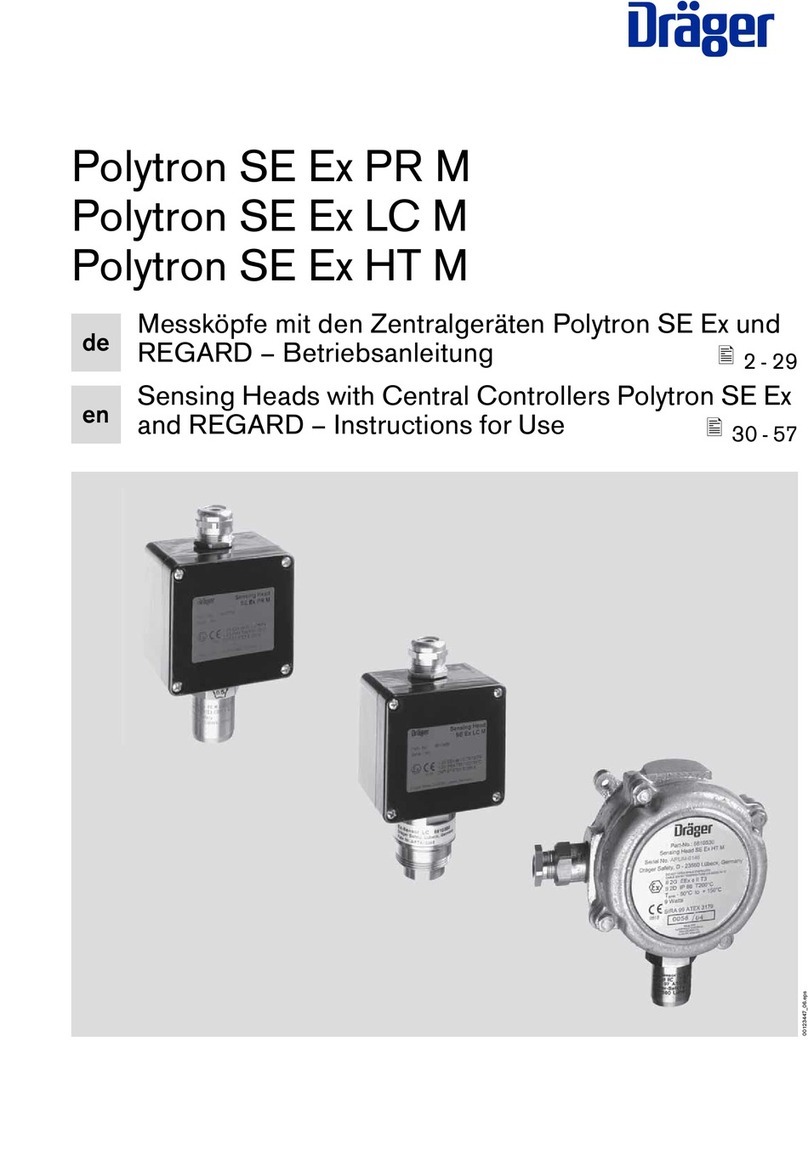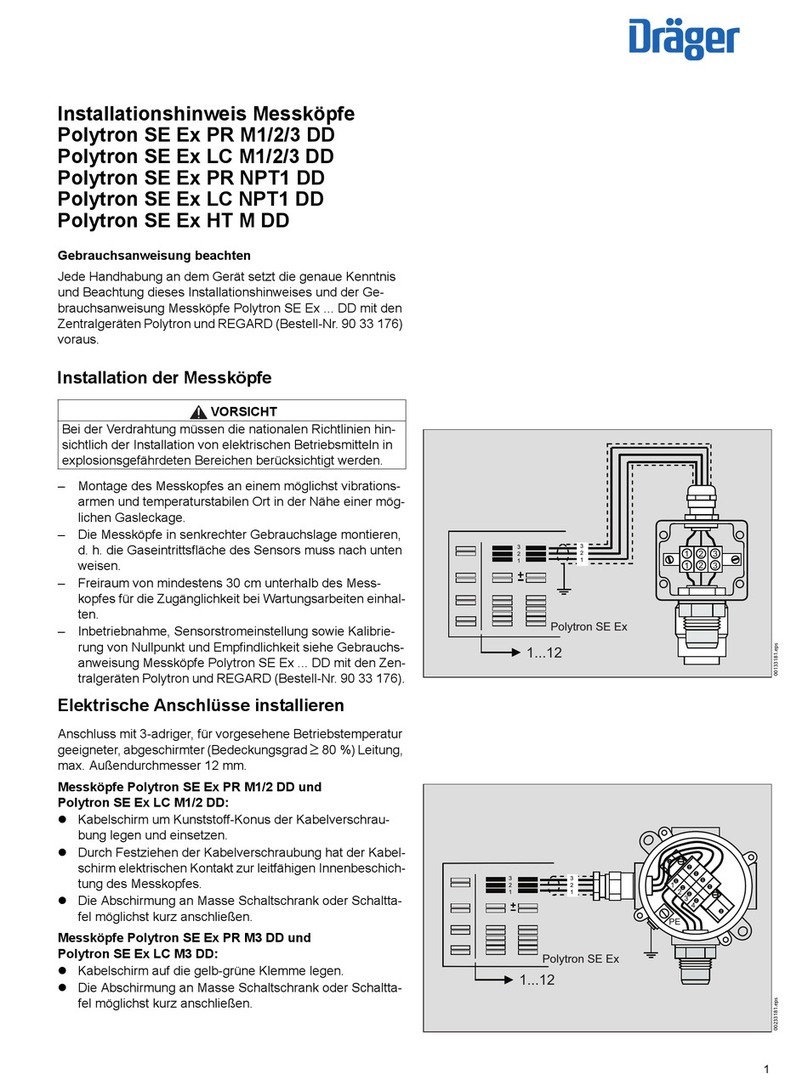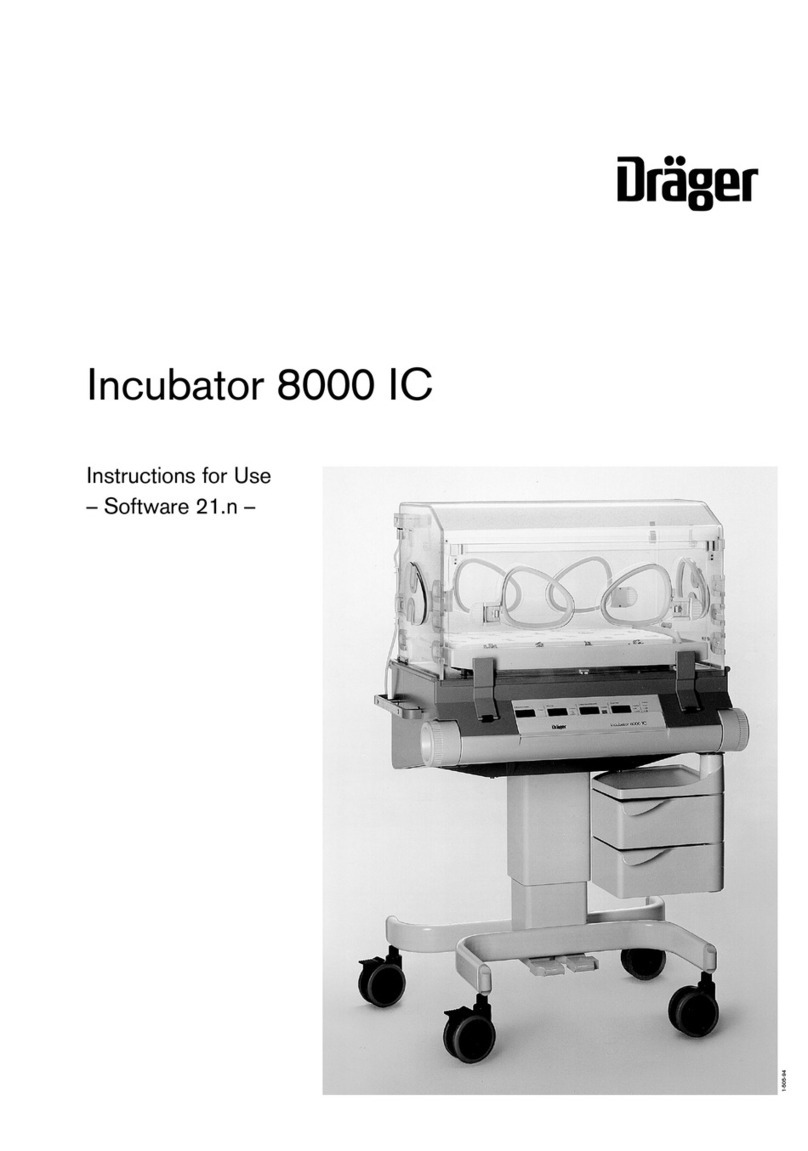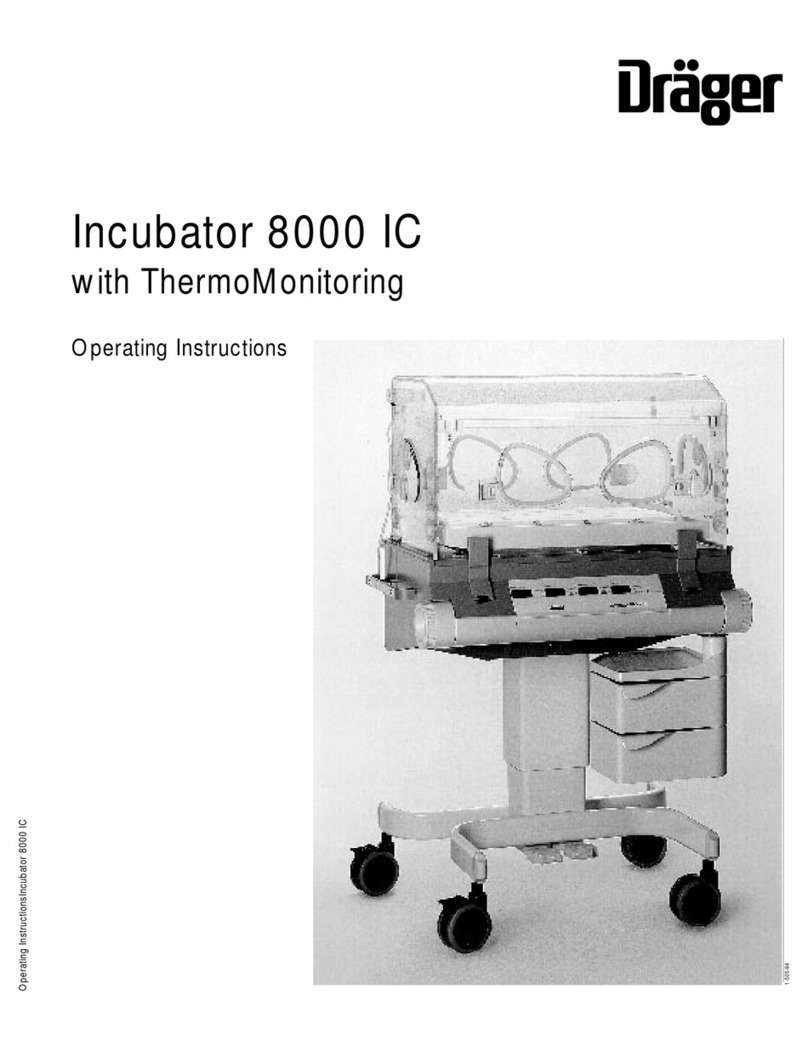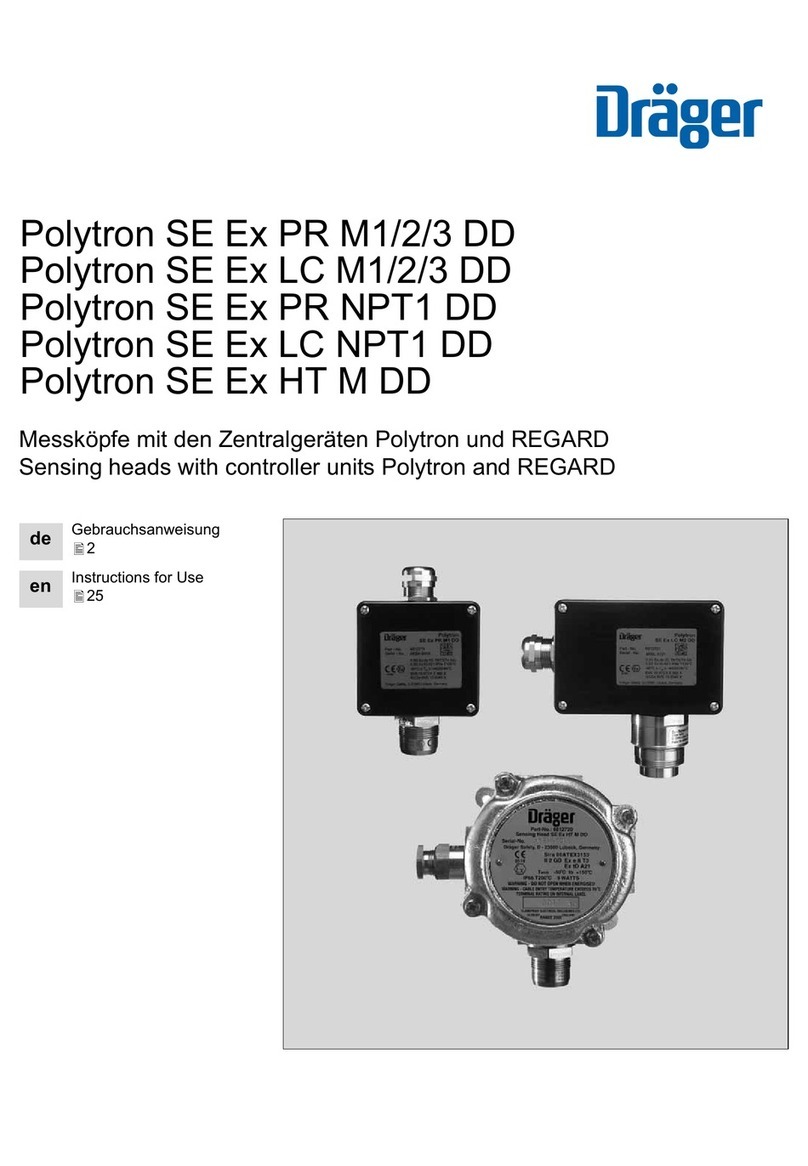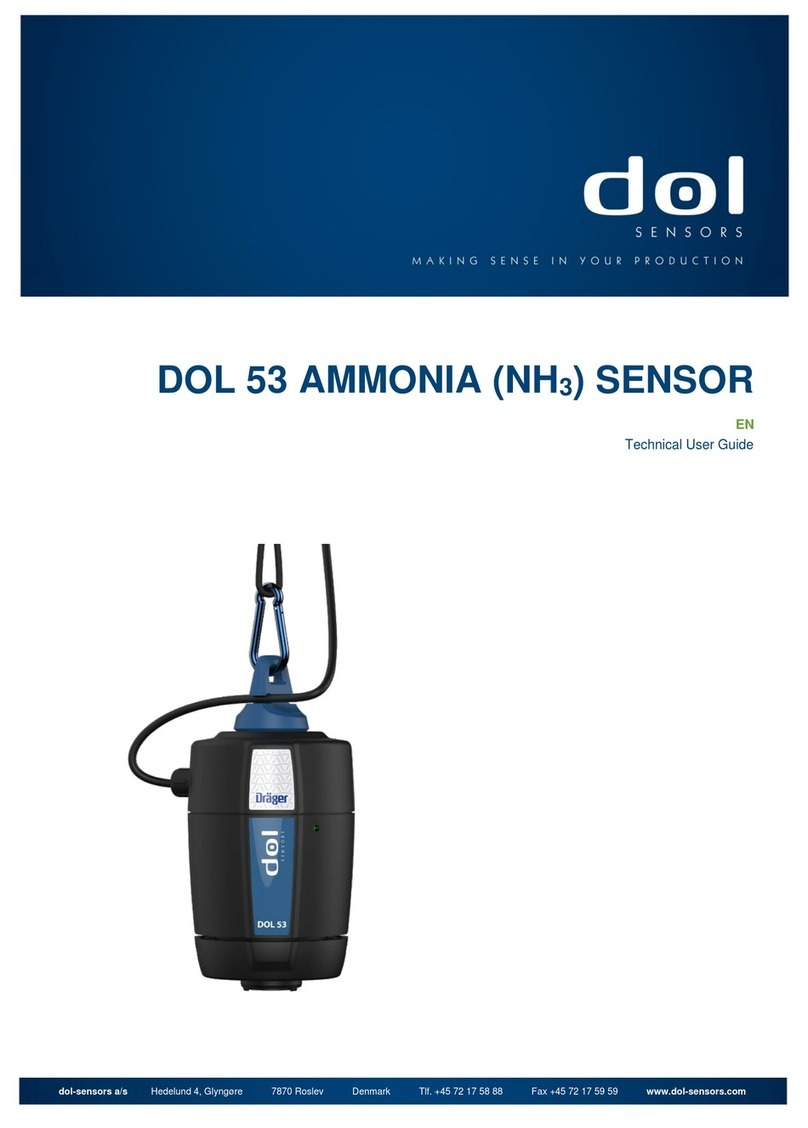
Dräger Polytron 8100 5
Contents
1 For your safety.........................................................7
1.1 General safety statements.........................................7
1.2 Definitions of alert icons.............................................7
2 Description ...............................................................8
2.1 Product overview .......................................................8
2.2 Intended use..............................................................8
2.3 Intended operating area and conditions.....................8
2.4 Design........................................................................8
3 Installation................................................................9
3.1 General information for installation ............................9
3.2 Installation restrictions ...............................................9
3.3 Impedance of signal loop.........................................10
3.4 Mechanical installation.............................................10
3.5 Electrical installation without Docking Station..........10
3.5.1 Electrical connection for 4-20 mA/HART interface...10
3.5.2 Electrical connection for fieldbus interface...............10
3.5.3 Relay option.............................................................11
3.6 Electrical installation with Docking Station...............11
3.6.1 Field wiring...............................................................11
3.7 Installing sensor.......................................................12
3.8 Installation of EC sensing head remote...................12
3.8.1 Wall or pipe mounting kit..........................................12
3.8.2 Installing sensor.......................................................12
3.9 Connecting the EC sensing head remote to ...............
Polytron 8100 .......................................................................12
3.10 Connecting the instrument to a controller
from Dräger..............................................................12
3.11 Connecting the instrument to a PC..........................12
3.12 Dräger PolySoft PC software (optional)...................12
3.13 Installing software dongles.......................................13
4 Operation................................................................13
4.1 Normal operation .....................................................13
4.1.1 Analog signals..........................................................13
4.2 The display and LEDs..............................................14
4.2.1 Measuring mode ......................................................14
4.2.2 Special states...........................................................14
4.2.3 The LED symbols.....................................................14
4.2.4 Status indicators in the display ................................14
4.3 Activating the Info mode ..........................................15
4.4 Activating the Quick Menu.......................................15
4.5 Menu navigation.......................................................15
4.5.1 Password .................................................................16
4.5.2 Graphic symbols ......................................................16
4.5.3 Changing parameter values or statuses ..................16
4.5.4 Exiting the menu ......................................................16
5 Menu........................................................................16
5.1 Menu overview.........................................................17
5.2 Information instrument .............................................18
5.2.1 Warning messages ..................................................18
5.2.2 Fault messages........................................................18
5.2.3 Installed modules.....................................................18
5.3 Information sensor ...................................................18
5.3.1 Display last calibration date.....................................18
5.3.2 Display next calibration due date.............................18
5.3.3 Vitality ......................................................................18
5.3.4 Sensor temperature .................................................18
5.4 Information data-logger........................................... 18
5.4.1 Display the data-logger status................................. 18
5.4.2 Display graph .......................................................... 18
5.5 Calibration............................................................... 18
5.5.1 Zero calibration ....................................................... 18
5.5.2 Span calibration ...................................................... 18
5.5.3 Auto calibration ....................................................... 18
5.6 Settings SIL activation............................................. 19
5.7 Combinations of acknowledgments, latching and
the corresponding relay/ LED status....................... 19
5.7.1 Acknowledgments and latching............................... 19
5.7.2 LED status:.............................................................. 19
5.7.3 Combinations with corresponding LED and
relay status:............................................................. 20
5.8 Settings instrument ................................................. 21
5.8.1 Alarm settings ......................................................... 21
5.8.2 Passwords............................................................... 22
5.8.3 Date and time.......................................................... 22
5.8.4 Language................................................................ 22
5.8.5 Function key............................................................ 23
5.8.6 Device initialization.................................................. 23
5.8.7 Bump test................................................................ 23
5.8.8 Software dongle ...................................................... 23
5.8.9 Display settings....................................................... 23
5.9 Settings communication.......................................... 24
5.9.1 HART interface........................................................ 24
5.9.2 Analog interface ...................................................... 24
5.9.3 Modbus ................................................................... 26
5.9.4 Profibus address ..................................................... 26
5.10 Settings sensor ....................................................... 27
5.10.1 Sensor change........................................................ 27
5.10.2 Auto CAL................................................................. 27
5.10.3 Sensor test.............................................................. 27
5.10.4 Sensor lock ............................................................. 27
5.10.5 Sensor type............................................................. 27
5.10.6 Gas settings ............................................................ 28
5.10.7 Reset sensor........................................................... 28
5.10.8 Calibration interval .................................................. 28
5.10.9 Set sensor test ........................................................ 28
5.10.10Fast response ......................................................... 28
5.10.11Display capture ....................................................... 28
5.11 Data-logger ............................................................. 29
5.11.1 Data-logger on or off ............................................... 29
5.11.2 Set data-logger........................................................ 29
5.11.3 Clear data-logger .................................................... 29
6 Maintenance .......................................................... 30
6.1 Maintenance intervals ............................................. 30
6.1.1 During commissioning............................................. 30
6.1.2 Every 6 months....................................................... 30
6.1.3 Change sensor on demand..................................... 30
6.2 Calibration............................................................... 30
6.2.1 Zero Calibration....................................................... 31
6.2.2 Span calibration ...................................................... 31
6.2.3 Auto Calibration....................................................... 32
6.3 Troubleshooting ...................................................... 33
6.3.1 Fault reference........................................................ 33
